Mastering Rug Care on Hardwood Flooring
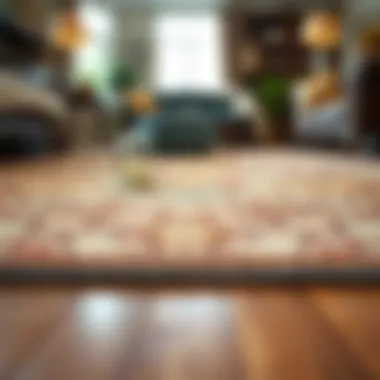
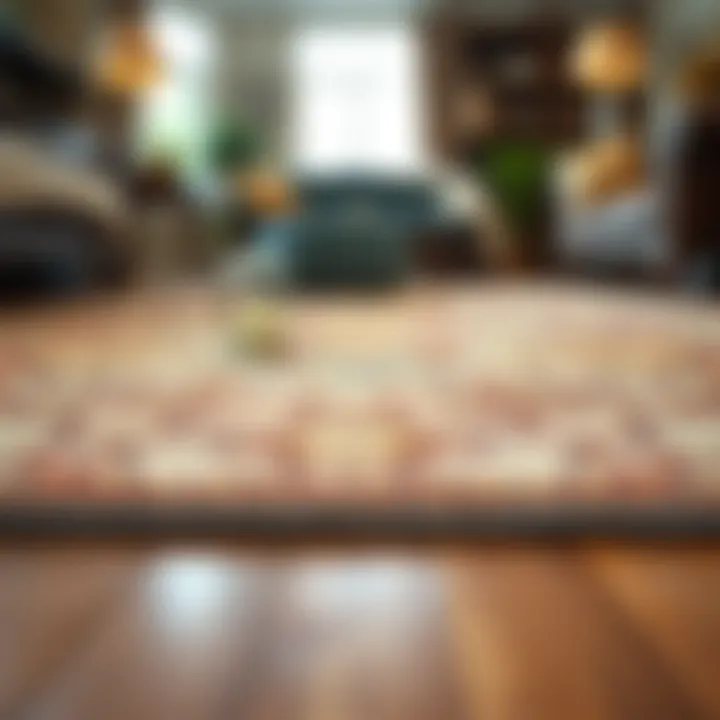
Intro
Cleaning rugs on hardwood floors isn’t just a chore; it’s an art that requires a thoughtful approach. Hardwood floors are known for their elegance, while rugs offer comfort and style. However, the two can present unique challenges when it comes to maintenance. To keep these prized possessions looking their best, homeowners must strike a delicate balance between preserving the integrity of the rug and the beauty of the floor beneath it.
Imagine this: a lavish Persian rug sprawled across warm oak flooring, both functioning as a visual centerpiece for your living space. It’s essential to maintain the harmony between these elements. Whether it’s a tiny entryway mat or a grand area rug, each type has its own cleaning requirements that can greatly affect its lifespan and appearance. A thorough understanding of the characteristics of both rugs and hardwood floors is the first step in the cleaning process. Let’s dive deeper into the design inspirations that can influence not just aesthetics but also practical care.
Design Inspirations
When considering rugs for your hardwood floors, one must think beyond mere functionality. Choosing the right rug can vastly enhance the design of a room, ensuring it complements and elevates the hardwood beneath.
Trending Styles
Rug trends come and go, but some styles have managed to stand the test of time. From geometric patterns to organic shapes, the best choices depend largely on the existing decor. At present, areas such as mid-century modern have taken the spotlight again, with rugs that are bold yet minimalistic.
You might prefer a bohemian aesthetic, where multi-colored, textured rugs can add warmth and depth, especially on lighter-colored hardwood. Similarly, natural fibers like jute or sisal are trending for their eco-friendly appeal, providing a rustic touch that pairs exquisitely with reclaimed wood floors.
Color Palettes
The color palette can make or break a room’s look. Soft, neutral tones like beige or gray are perennial favorites as they tend to merge seamlessly with various hardwood shades. On the flip side, vibrant colors can act as a striking focal point, creating visual contrast that commands attention. It’s wise to consider durability in color choice too—darker hues may hide dirt better but require careful cleaning to avoid fading.
Incorporating patterns can add an extra layer of interest. Floral prints, tribal designs, or simple stripes can all interact beautifully with the rich texture of hardwoods. But be wary; too much busyness can overwhelm a space, leading to a chaotic visual effect.
Tip: Think about both function and form when selecting a rug. Consider how often the area will be used and the general foot traffic to determine the best fit.
Maintenance and Upkeep
Keeping the rugs clean on hardwood floors is not simply about vacuuming once in a while. A well-planned maintenance routine can extend the life of your rug and protect your flooring.
Seasonal Maintenance Checklist
- Spring Cleaning: Time to air out your rugs. Roll them outside and hang them for a bit to allow fresh air to eliminate any lingering odors.
- Fall Check-Up: Inspect for wear and tear. Fix any loose threads or edges before they become bigger problems.
- Winter Preparation: When winter rolls around, consider using boot trays at entrances to minimize dirt transfer to rugs.
Cleaning and Organization Tips
Keep these key points in mind:
- Vacuum Regularly: Aim for at least once a week to trap dirt before it settles.
- Use a Rug Pad: Placing a pad underneath your rug not only provides cushioning but also minimizes slipping and prevents the rug from scratching the hardwood.
- Spot Clean: Address spills and stains immediately. Use a damp cloth with mild soap and pat—don’t rub—to avoid spreading the stain.
- Rotate Your Rugs: Every six months, rotate them to ensure even wear and to maintain their lively appearance.
By understanding these insights into cleaning techniques, styles, and maintenance routines, your rugs can maintain their sophistication just as your hardwood floors do. This knowledge empowers homeowners to not only keep their spaces inviting but also functional and long-lasting.
Understanding the Relationship Between Rugs and Hardwood Floors
When we talk about rugs and hardwood floors, we're not just discussing mere floor décor or comfort. This relationship is intricate and necessitates a deeper understanding for homeowners and interior design enthusiasts alike. Rugs can add warmth and style, while hardwood floors exude elegance and durability. However, blending the two requires careful consideration.
It's essential to recognize that rugs can either enhance or detract from the beauty of hardwood floors. A well-chosen rug can accentuate the grain and color of the wood, creating a harmonious living space. In contrast, an incompatible rug can lead to issues like scratches or color fading, undermining the floor's natural beauty. Choosing the right rug involves considering materials, colors, and patterns that complement the flooring rather than clash with it.
The Importance of Choosing Compatible Rugs
Selecting a compatible rug goes far beyond aesthetics. Consider the rug's back material and fiber, as these can significantly impact the hardwood flooring. For example, rubber or latex backing may cause discoloration or trap moisture underneath, risking detrimental long-term effects. Instead, opting for natural fibers like wool or cotton can provide comfort and breathability.
Moreover, the size and shape of the rug play a pivotal role. A too-small rug can make a room feel disjointed, while oversized options might overwhelm the space. Ensuring the right dimensions allows for a more cohesive look and better flow in the room.
In terms of benefits, a properly chosen rug can act as an effective barrier against dirt and debris that would otherwise settle on hardwood floors. It also provides extra cushioning, making areas more comfortable — especially essential for high-traffic zones like living rooms or hallways. With a thoughtful choice, a rug can maintain the hardwood's integrity while offering style and comfort.
"Choosing the right rug is like finding a partner; it should complement your style while enhancing your overall experience."
Potential Risks of Using Rugs on Hardwood
Using rugs on hardwood floors isn't without its potential pitfalls. One significant concern is the risk of moisture damage. If a rug becomes damp—be it from spills, humidity, or cleaning—it can lead to mold growth, affecting both the rug and the underlying floor. Therefore, choosing quick-drying materials can help mitigate this risk.
Another issue relates to slipping and sliding. Rugs that lack proper grip can cause accidents, especially in homes with children or elderly individuals. Utilizing non-slip rug pads can remedy this concern, providing a secure footing while allowing the rug to do its job.
It's also vital to consider fading. Some rugs can lose their vibrancy over time, especially if exposed to direct sunlight. This fading can ultimately draw attention away from the elegant finishes of hardwood flooring. To protect both investments, consider using window treatments or UV-blocking films to shield from sun damage.
In summary, understanding the dynamics between rugs and hardwood floors is key to maintaining an appealing living space. Choosing compatible rugs not only enhances aesthetic appeal but also elevates the overall functionality of your home. Ignoring compatibility can lead to significant risks that undermine both the rug and the hardwood's longevity.
Preparation for Cleaning Rugs on Hardwood Floors
Before diving headfirst into the cleaning process, it's vital to take a few preparatory steps. Preparation not only ensures an effective cleaning experience but also safeguards your hardwood floors from any potential damage. A well-prepared environment fosters greater efficiency and results in a cleaner rug. One must not underestimate the value of this groundwork; it lays the foundation for a smooth, hassle-free routine.
Gathering Essential Cleaning Supplies
Having the right tools at your disposal can make all the difference in the cleaning process. Let's take a closer look at essential supplies that should be part of your cleaning arsenal.
Vacuum Cleaner
A vacuum cleaner is a must-have tool for cleaning rugs effectively without damaging hardwood floors. Opting for one with adjustable suction is advantageous as it allows you to tailor the power based on the rug’s material. Many homeowners favor bagless models due to their convenience and ease of emptying. A notable feature is the ability to switch between various surfaces, ensuring the right setting for both the rug and the flooring beneath. However, a downside might be that if the vacuum is too powerful, it could potentially cause some wear to delicate rug fibers.
Brushes
When it comes to brushes, those specifically designed for rugs can greatly enhance your cleaning routine. A good brush should have soft bristles to avoid scratching the hardwood while being effective enough to lift debris from the fibers of the rug. Many householders prefer brushes with ergonomic handles, making them easier to maneuver. On the other hand, if you don't select the right bristle type, you might end up damaging the texture of the rug, which leads to premature wear and tear.
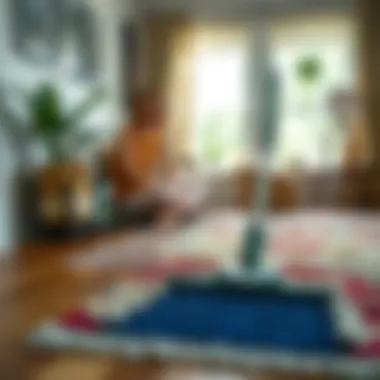
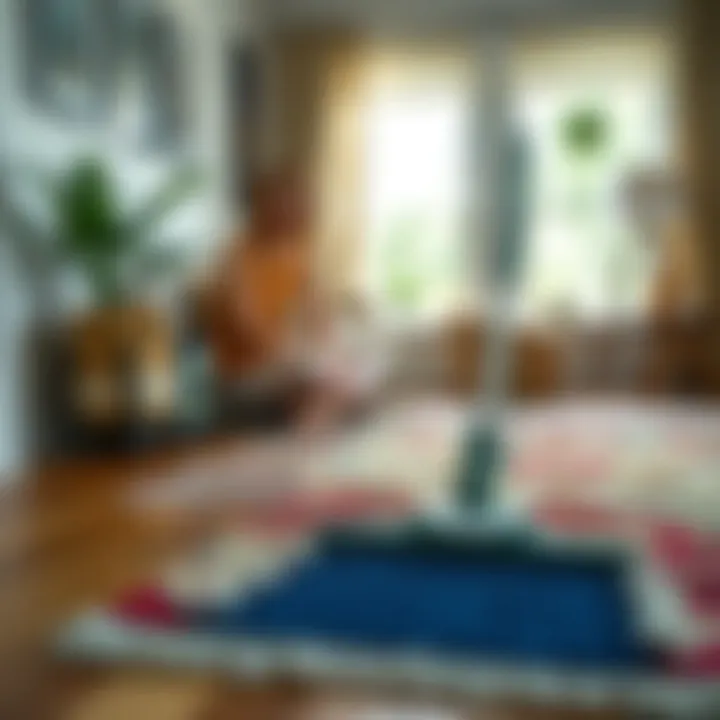
Cleaning Solutions
Choosing the right cleaning solution is critical for maintaining the balance between cleanliness and protection. Look for pH-neutral cleaners, as these will not harm either the rug or the hardwood. A unique feature of some cleaning solutions is that they come in concentrated forms, allowing for economical use. However, using too much product or harsh chemicals can lead to residue build-up on the rug and dullness on hardwood surfaces. Always remember to check compatibility with your rug's fabric to avoid unwanted surprises.
Microfiber Cloths
Microfiber cloths are versatile and essential in any cleaning process. Their ability to trap dirt and dust without scratching surfaces makes them particularly valuable. Unlike standard cloths, microfiber is designed to lift particles, which means less effort is needed to achieve a spotless finish. A downside is that they’re often more expensive than regular cleaning cloths, but most users find the investment worthwhile due to their longevity and effectiveness.
Preparing the Area for Cleaning
Proper preparation of the area is just as important as gathering supplies. It not only ensures that cleaning goes smoothly but also protects flooring and furniture during the process.
Removing Furniture
Clearing the space by removing furniture is a fundamental step in the cleaning process. If furniture is left in place, not only are you going to miss out on fully cleaning the rug, but you might inadvertently damage both the rug and the hardwood floors. Moving heavy items allows for a thorough clean and prevents scratches that can occur if furniture shifts during vacuuming. This step also promotes a sense of organization in your space, which can be refreshing to see.
Protecting Flooring
Before starting the cleaning job, take measures to protect your hardwood floors. Using drop cloths or old towels beneath the rug can safeguard the wood from any cleaning products that might drip. This step can prevent unwarranted water exposure, which can warp wood over time. Additionally, ensuring rugs are secured with non-slip pads can help avoid movement during the cleaning process. Without these precautions, the risk of long-term damage to your hardwood is significantly increased, nullifying all efforts taken during the cleaning itself.
"Preparation is the key to success." Ensuring the right supplies and a protected area sets you up for a successful rug-cleaning mission.
Vacuuming the Rug: A Prerequisite
Cleaning rugs that are placed over hardwood floors begins long before any soap or scrubbing can take place. The first step in keeping both rugs and floors in top condition is vacuuming. It might sound simple, but this everyday chore holds significant weight in maintaining the longevity and appearance of your home’s decor. Dust, debris, and pet hair can become embedded in rug fibers, making eventual cleaning a harder and less effective task.
Regular vacuuming prevents dirt from settling deep, where it could cause fibers to break down and possibly stain the wood beneath. For anyone looking to keep their rugs looking their best while ensuring the hardwood remains undamaged, vacuuming becomes a non-negotiable practice in the care manual.
Choosing the Right Vacuum Settings
When it comes to vacuuming rugs, understanding the correct settings on your vacuum can lead to better outcomes. Many modern vacuum cleaners come with multiple settings to accommodate different carpet types and flooring.
- Adjusting Suction Power: Lower suction settings are often best for delicate area rugs to prevent any snagging or damage. Conversely, higher settings can assist in lifting more dirt from thicker, plush rugs.
- Brush Roll Usage: If your vacuum has a brush roll feature, it can be turned off for flat weaves rugs but should be engaged for thicker pile carpets. Failing to toggle these options correctly can lead to a less effective cleaning process or even cause harm to your cherished rugs.
Using the right settings allows for a deeper clean without compromising the integrity of the fabric.
Techniques for Effective Vacuuming
Mastering the vacuuming process enhances its benefits and ensures that your rugs last longer while looking aesthetically pleasing. Here are a couple of techniques worth mentioning:
Direction of Vacuuming
The direction in which you vacuum can make a significant difference. Vacuuming in the direction of the rug fibers ensures a deeper clean, as the vacuum can more effectively lift dirt and debris trapped at the base of the fibers.
- Key Characteristic: It mirrors the natural laying of the fibers and doesn’t disrupt their arrangement, which can be crucial in preserving the texture and feel.
- Why It’s Beneficial: This method not only cleans dirt better but also maintains the rug’s appearance, avoiding unnecessary wear and tear.
Conversely, vacuuming against the grain can sometimes dishevel the fibers and lead to visible flattening, which detracts from the overall look.
Frequency of Maintenance
The frequency with which you vacuum your rugs can’t be overlooked. Regularly scheduled vacuuming – ideally once a week or more often in high-traffic areas – helps maintain cleanliness.
- Key Characteristic: High-traffic areas tend to accumulate dirt faster, so targeting these spots can be particularly advantageous.
- Why It Matters: Keeping up with vacuuming prevents the buildup of allergens and dust, contributing to a healthier living environment.
Long-term neglect of this routine may lead to the necessity for more intensive cleaning, which can be labor-intensive and sometimes requires professional intervention.
In essence, treating vacuuming as a prerequisite lays down the foundation for effective rug care on hardwood floors. It helps extend the lifespan of both rugs and the underlying surfaces, contributing to a harmonious ambiance in your home.
Spot Cleaning Techniques for Rugs
Spot cleaning is an essential skill for maintaining the beauty of rugs on hardwood floors. This technique focuses on addressing specific stains and spills before they become more significant problems, protecting both the rug and the hardwood underneath. By mastering spot cleaning, homeowners can not only extend the lifespan of their rugs but also keep their living spaces looking their best.
Identifying Stains and Their Solutions
Common Stains
Understanding common stains is vital for successful spot cleaning. These stains can come from various sources, including spills from beverages, food, or even bodily fluids. Each type of stain has unique characteristics, requiring tailored approaches for removal. For instance, red wine may need an entirely different technique than mud or ink.
Common stains are notorious for their stubbornness, often penetrating deep fibers of the rug, making removal a daunting task without proper methods. Ignoring these stains can lead to discoloration, which could ruin the aesthetic appeal of the rug. Knowing how to identify and treat them is a beneficial element of this article, empowering readers to act swiftly against unsightly marks.
Here’s a quick rundown of common stains and their telltale signs:
- Red Wine: Deep burgundy color can seep quickly.
- Coffee: Dark brown spots often surrounded by a faded area.
- Grease: Slightly glossy texture that doesn’t blend easily into the fabric.
- Ink: Distinct blue or black marks that can spread if not treated.
Home Remedies
When it comes to tackling stains, home remedies can be incredibly helpful. These often-use ingredients can be found in almost any household, making them a convenient choice for emergencies.
Home remedies are favored because they tend to be less harsh than commercial products, reducing the risk of damaging either the rug or the hardwood beneath it. For example, a mixture of vinegar and water can effectively lift many types of stains while being gentle on fibers. However, some homemade solutions may not have the same effectiveness as store-bought cleaners, depending on the stain type.
One must be cautious because using the wrong remedy can sometimes cause further discoloration or damage. Identifying the correct remedy for the specific stain can lead to positive results without the downsides often associated with harsher chemicals.
Application of Spot Cleaners
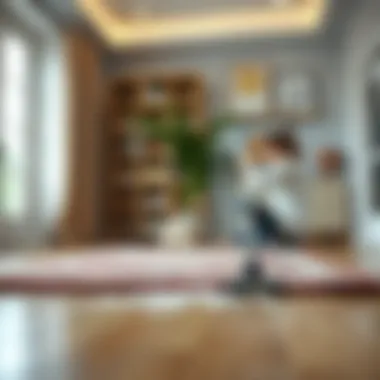

Testing on Small Areas
Before diving into the application of any spot cleaner, it’s critical to conduct a test on a small, inconspicuous area of the rug. This small test ensures that the cleaning solution won’t adversely affect the colors or texture of your beloved rug.
Testing is an excellent practice in preserving the integrity of the fibers. It serves as a safeguard, enabling homeowners to see how the material reacts without risking visible damage. This method is particularly beneficial for exotic or vintage rugs, where the fibers can be fragile or dyed with sensitive colors.
Blotting Techniques
Once a stain is identified and the appropriate cleaner selected, blotting becomes the next crucial step. Instead of scrubbing vigorously, which may damage the fibers or push the stain deeper, blotting gently lifts the stain from the rug.
Blotting techniques are favored because they help maintain the physical structure of the rug while effectively removing stains. The unique feature of this method is its ability to work with most types of stains, from liquid spills to solid messes. For the best outcomes, homeowners should utilize a clean, dry cloth or paper towel and avoid oversaturating the area, as this could lead to moisture seeping into the hardwood beneath.
"Proper spot cleaning techniques can save both your rug and your hardwood floors from being irreparably damaged."
In summary, spot cleaning is not merely a task to put off for later. By effectively identifying stains, applying remedies cautiously, and using techniques that preserve both rugs and floors, homeowners can ensure that their spaces remain beautiful and well-maintained for years to come.
Deep Cleaning Options for Rugs
Deep cleaning rugs placed on hardwood floors is essential for various reasons. Over time, dirt, allergens, and stains can accumulate, not only affecting the visual appeal of your rugs but also compromising the health of your living space. Understanding when and how to deep clean your rugs can preserve their lifespan and ensure your hardwood floors remain unaffected by moisture or damage. Here, we're diving into the crucial aspects of deep-cleaning techniques to keep your rugs looking their best.
Understanding When to Deep Clean
Determining when to deep clean your rug is vital and often varies based on factors like the amount of foot traffic, the type of rug, and any visible signs of dirt or odor. Here’s what to look for:
- Frequent Traffic: High-traffic areas will accumulate dirt and grime faster. If your rug is in a space that's bustling with activity, it likely needs deep cleaning every 6 months.
- Visible Stains: Stains from spills or pets can linger, and if you've attempted spot cleaning without success, it might be time for something more thorough.
- Allergenic Concerns: If someone in your household has allergies, it's crucial to deep clean regularly, as rugs can trap dust mites and allergens.
- Odors: Any musty or unpleasant smells emanating from the rug are signs it needs a deep clean. Though deodorizing can help temporarily, it can't replace a good cleaning.
Knowing when to deep clean is half the battle; the actual cleaning method is the other crucial part.
Methods for Deep Cleaning
Steam Cleaning
Steam cleaning is often hailed as one of the most effective methods for deep cleaning rugs. The high-temperature steam penetrates the fibers, loosening dirt and allergens, effectively sanitizing the surface.
- Key Characteristic: The primary aspect of steam cleaning is its ability to utilize heat and moisture without soaking the rug, making this method gentler on both rugs and hardwood floors.
- Benefits: It's eco-friendly, as it often requires little to no chemicals, and the heat can eliminate up to 99% of bacteria and allergens, making your home healthier.
- Unique Feature: One of the distinctive features of steam cleaning is its versatility. It works on a variety of fabrics and rugs, from synthetic to natural fibers.
- Advantages/Disadvantages: While steam cleaning is highly effective, it also has its downsides. It requires special equipment and can take time to ensure the rug dries completely afterward to avoid any potential water damage to underlying hardwood floors.
Professional Services
Opting for professional carpet cleaning services can be another excellent route to achieving a thorough deep clean, especially for delicate or oversized rugs.
- Key Characteristic: Professional services bring equipment and expertise that most homeowners don't have, which can be particularly beneficial for high-value or antique rugs.
- Benefits: Using professionals ensures that the right techniques and products are used specific to your rug's material and construction, which reduces the risk of damage.
- Unique Feature: Many professional services provide additional benefits, such as protective treatments post-cleaning, which can safeguard against future stains and dirt buildup.
- Advantages/Disadvantages: Though this option might be pricier, the convenience and expertise provided can outweigh the cost, especially if you're dealing with a complex cleaning situation or an especially valuable rug.
Drying the Rug after Cleaning
Drying a rug after cleaning is not simply a matter of convenience; it's an essential step that can significantly impact both the rug's longevity and the health of the underlying hardwood floor. When a rug retains moisture, it poses several risks. This excess humidity can lead to mold growth, unpleasant odors, and, at times, can even warp the hardwood flooring beneath. A thorough drying process helps maintain the beauty and functionality of both the rug and the floor, ensuring a safe and pleasant living environment. The importance of proper drying techniques cannot be overlooked, and understanding how to approach this task effectively is key to mastering rug care.
Importance of Proper Drying Techniques
Utilizing proper drying techniques is critical in preventing both visible and hidden damage. It ensures that the surface fibers of the rug dry without becoming matted or discolored. Moreover, effective drying techniques help prevent the transfer of moisture to the hardwood floor, which can lead to long-term warping or staining.
Considering how rugs absorb water mixed with cleaning solutions, the right techniques help eliminate any residues that could, over time, cause deterioration or discoloration of the rug.
"A well-dried rug is a happy rug! A poorly dried one, on the other hand, can spell disaster for both the rug and the floor beneath."
Methods for Effective Drying
Air Drying
Air drying is one of the most straightforward methods for drying rugs after cleaning. It involves simply laying the rug flat in a well-ventilated area. This method is particularly advantageous due to its natural approach, using fresh air to dehydrate the rug without the use of heat, which might otherwise compromise delicate fibers. The key characteristic of air drying is its gentleness, making it a favored choice among homeowners conscious about their rugs.
However, while air drying is cost-effective and eco-friendly, it does require adequate time and space. Additionally, unideal weather conditions—like humidity or rain—can extend the drying period significantly.
Using Fans
Implementing fans can speed up the drying process significantly. Fans circulate air, hastening evaporation by maintaining airflow around the rug. This method is beneficial in conditions where moisture might linger otherwise, promoting a uniform drying effect. Using fans can be especially useful in enclosed spaces where air circulation is inadequate.
The unique feature of this approach lies in its ability to effectively combine speed with gentle care; unlike heaters, fans do not overheat the wool or other delicate fibers in the rug. However, it’s important to ensure that dust from surrounding areas doesn't settle onto the damp fibers from the circulation.
In summary, the drying of rugs after cleaning is as crucial as the cleaning process itself. By adopting air drying or utilizing fans, homeowners can enhance both the longevity of their rugs and protect their hardwood floors from potential damage.
Preventive Maintenance for Rugs on Hardwood Floors
Maintaining rugs on hardwood floors is akin to tending a delicate garden; neglect will lead to untimely deterioration. Preventive maintenance is essential in keeping the aesthetic charm of both rugs and flooring intact. Through regular upkeep, you can significantly extend the lifespan of your rugs while ensuring the underlying hardwood stays safe from potential damage.
Investing a bit of effort into preventive measures not only enhances the look of your home but can also save you from expensive repairs down the line. Let's dive into the key aspects of maintaining those beautiful rugs without compromising your wood floors.
Regular Maintenance Practices
Regular maintenance practices are the backbone of rug care, making the effort feel like second nature rather than a dreaded chore. Here are some essential practices to incorporate into your routine:
- Frequent Vacuuming: Regular vacuuming keeps dirt and debris at bay, preventing them from settling into the fibers and damaging the rug. For rugs placed on hardwood, consider using a vacuum that allows you to turn off the beater brush. This reduces the wear on both the rug and the hardwood beneath.
- Periodic Flipping: Rotate your rugs every few months. This simple act prevents uneven wear and fading due to sun exposure or foot traffic in one area. A twirl here and there keeps things fair—like sharing dessert, it’s only fair!
- Spot Cleaning: Life happens, and spills are inevitable, especially for those who entertain or have children and pets. When accidents occur, spot clean right away. Blot the area with a damp cloth, and avoid scrubbing, which can damage the fibers.
It’s always easier to nip a small issue in the bud than to deal with a full-blown mess later. Regular maintenance practices can act as a shield, keeping your rugs as lovely as a spring meadow.
Protective Measures for Flooring
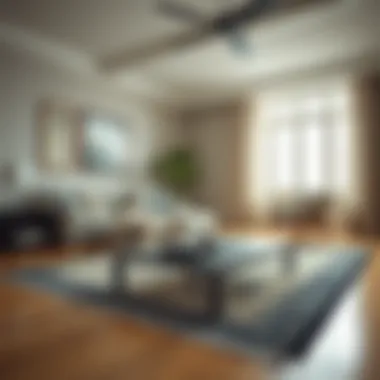
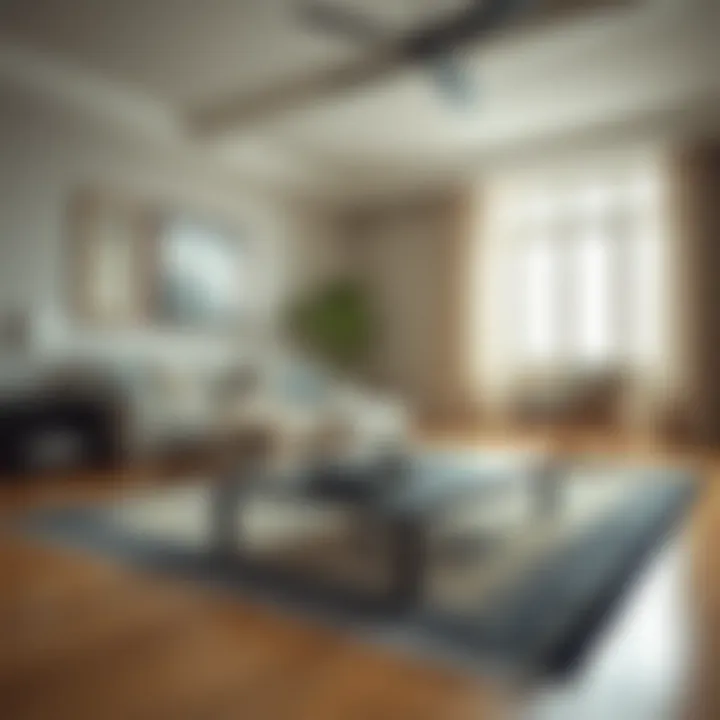
Protection is vital when it comes to preserving the integrity of hardwood floors while enjoying the beauty of rugs. The right choices can make all the difference in ensuring both stay in tip-top shape.
Rug Pads
Rug pads are an essential yet often overlooked tool in the battle against wear and tear. They serve as a buffer between the rug and hardwood, which can also prevent the rugs from slipping and sliding around.
- Key Characteristic: The cushioning nature of rug pads helps absorb impact and prevents the rug from rubbing against the hardwood, thereby minimizing scratches.
- Benefit: They are an excellent choice because they extend the life of both your rug and floor. A good rug pad contributes to comfort underfoot, almost like putting on a pair of cozy socks—suddenly, everything’s better!
- Unique Feature: Some rug pads even have moisture-resistant properties. This prevents any spills that might seep through the rug from damaging the hardwood beneath. However, be cautious, as not all pads come with such features, so it’s best to research or ask about them.
Strategic Placement
Strategic placement of rugs is another prudent measure. Placing them appropriating can mitigate potential risks to your hardwood floors.
- Key Characteristic: The layout of your rooms should take into account the traffic areas where rugs will live their best lives. Finding a good fit means accounting for the usual footfall.
- Benefit: By placing rugs in designated areas, you limit the exposure of hardwood to damage—from dirt, scratches, and the occasional drink spill. Think of it like a defensive play—you're keeping your star player (the hardwood) safe while letting the rugs shine.
- Unique Feature: Areas prone to high traffic may need additional layers of protection, like larger rugs or outdoor mats. Using a more robust rug in those spaces can absorb the wear the hardwood would take.
Addressing Common Issues with Rugs on Hardwood
Rugs and hardwood floors often share a delicate dance in home interiors, each contributing to the overall ambiance. However, with such a relationship comes the need to address specific issues that might arise. Failing to manage these problems can lead to costly repairs or the early demise of both rugs and floors. Having a solid approach can maintain both aesthetics and functionality, which is crucial for any homeowner or decoration enthusiast.
Managing Odors
One of the most persistent issues with rugs on hardwood floors is unpleasant odors. Rugs can absorb smells from pets, food spills, or simply from accumulated dust and allergens. The importance of addressing this issue cannot be overstated. An odor-laden rug can quickly ruin the inviting atmosphere of a room. To effectively manage odors, consider the following strategies:
- Regular Vacuuming: Frequent vacuuming helps remove dust and dander that can contribute to odors. Make sure to use a vacuum designed for rugs to avoid damage.
- Baking Soda Treatment: This age-old remedy is both effective and simple. Sprinkling baking soda on the rug allows it to absorb odors. After leaving it for a few hours, just vacuum it up!
- Vinegar Solution: A mixture of equal parts white vinegar and water can work wonders. Lightly mist the rug, let it air out, then vacuum once dry. This natural method not only deodorizes but also sanitizes the fibers.
Keep in mind, while these techniques are beneficial, it’s vital to test any solution on a small, inconspicuous area first to ensure it won’t damage the rug or hardwood finish.
Dealing with Slipping Rugs
Another common woe among homeowners is the problem of rugs slipping on hardwood floors. Beyond being merely bothersome, slipping rugs can pose a significant tripping hazard, especially in homes with children or elderly residents. To counteract this issue effectively, consider implementing these practical solutions:
- Rug Pads: Investing in high-quality rug pads is one of the best strategies to keep rugs in place. These pads create friction, preventing movement while also providing added cushioning and protection for the hardwood underneath.
- Double-Sided Tape: If the rug remains problematic, double-sided tape can be a temporary fix. Applying strips to the corners of the rug can help to secure it to the floor without leaving a permanent mark.
- Weighted Edges: Rugs with weighted edges can help keep them grounded. If a rug tends to curl or lift, consider sewing some weight into the edges to maintain its shape and position.
By implementing these techniques, homeowners can mitigate slipping, ensuring that their living spaces remain both safe and aesthetically pleasing. Addressing these common issues doesn’t just improve daily life; it enhances the lifespan of both the rugs and the hardwood floors, allowing for a more harmonious environment.
"A little effort in addressing these common problems today leads to a more pleasant living space tomorrow."
Understanding the Lifespan of Rugs on Hardwood Floors
Understanding the lifespan of rugs placed on hardwood floors is essential for any homeowner looking to maintain both aesthetic appeal and functionality. Rugs can elevate the look of a room, adding warmth and texture; however, their durability is influenced by a variety of factors. Recognizing these elements can ensure that your rugs not only fit seamlessly into your design but also withstand daily wear and tear. This comprehensive overview discusses how to maximize the longevity of your rugs while protecting the hardwood underneath.
Factors Affecting Rug Longevity
Several factors play a significant role in determining how long a rug will last, especially when paired with hardwood floors. Here are the most salient points to consider:
- Material Composition: The fabric from which the rug is made greatly influences durability. Natural fibers like wool tend to withstand more use and resist stains, while synthetic materials may offer initial softness but can degrade quicker under heavy traffic.
- Quality of Construction: Handmade rugs often outlast machine-made ones. Look for tight weaving and quality finishes; these characteristics generally indicate a more robust construction.
- Traffic Patterns: Areas with high foot traffic will naturally wear down rugs faster. Placing rugs in lower-traffic areas, or rotating them periodically to distribute wear, can help extend their life.
- Maintenance Routine: Regular cleaning—both vacuuming and deep cleaning—keeps dirt and grime from becoming embedded in the fibers, which can accelerate wear. Implementing spot cleaning as soon as spills occur can make a big difference as well.
- Environmental Factors: Exposure to sunlight can fade colors and weaken fibers over time. Using UV window treatments or strategically placing rugs in shaded areas can help mitigate this risk.
Understanding these elements can help homeowners make informed decisions regarding their rugs, from the initial selection to ongoing care.
Signs It's Time for Replacement
Despite everyone's best efforts, occasionally a rug will have to be retired to the great carpet store in the sky. Keeping an eye out for specific indicators will help you discern when it's time to invest in a new rug. Here are signs to look for:
- Fading or Discoloration: If a rug’s color looks washed out or uneven, it could be a sign of age and damage. Since maintaining the aesthetics of hardwood floors is crucial, a faded rug can be more than just an eyesore.
- Fraying Edges or Holes: Check the borders and surface of the rug for fraying or holes. These imperfections can worsen over time, leading to further unraveling of the fibers.
- Persistent Odors: Sometimes, odors can become trapped in the material. If cleaning fails to eliminate unpleasant smells, replacing the rug might be the most practical course of action.
- Stains That Won't budge: If stains have become permanent despite your best efforts to remove them, it might be time to say goodbye and seek a new addition to your home.
- Rug Is Bowing or Bunching: If the rug no longer lies flat and refuses to stay in place, despite efforts to flatten it, this could be a sign of structural failure. This can lead to a tripping hazard as well—a risk not worth taking on hardwood floors.
By staying attuned to these signs, homeowners can make proactive decisions that enhance their living spaces rather than detract from them.
"Regular maintenance checks can make the difference between a rug that lasts and one that's destined for the bin."
Keeping these points in mind aids in not just maintaining rugs, but in effectively blending aesthetics with practicality. Engaging in regular assessments will help ensure that rugs continue to contribute positively to your hardwood floors.
Closure: The Balance of Aesthetics and Care
Cleaning rugs on hardwood floors is not just a task; it’s an art form that marries aesthetics with practical maintenance. This article has traversed the various facets involved in preserving the beauty of both rugs and hardwood floors. It’s clear that keeping these elements in harmony is essential for creating an inviting living space.
One key takeaway is the importance of routine maintenance. Regular cleaning and care prevent dirt buildup, which could lead to damaging the floors beneath. Incorporating regular vacuuming into your schedule can drastically reduce the wear and tear on both rugs and hardwood surfaces. These simple practices lead to longevity, especially when paired with thoughtful selections of compatible rugs that do not compromise the integrity of the flooring underneath.
Furthermore, the significance of employing proper protective measures, like using rug pads, cannot be overstated. They add cushioning that not only protects the hardwood but also enhances the comfort of the carpeted areas.
In envisioning your home, the balance of style and functionality is paramount. A beautiful rug adds warmth and character, yet without the right maintenance approach, its charm could quickly fade. Homeowners and design enthusiasts must assess how their choices influence their space continuously. Care should go hand-in-hand with aesthetics, preserving the visual appeal without neglecting practical upkeep.
"A beautiful space is not simply a matter of appearance; it’s about intentional choices that nurture both form and function."
The Importance of Routine Maintenance
Routine maintenance serves as the backbone of sustaining your rugs on hardwood floors. Not only does it prolong the life of these items, but it also preserves the overall environment in your home. Cleaning your rugs regularly means they will remain vibrant and fresh, reducing odors and allergens that might otherwise accumulate.
Moreover, consistent care allows you to catch minor issues before they escalate. A stain, if addressed soon, is far easier to manage than one that sits and seeps into the fabric. With rugs, prevention truly is better than cure. Here are some tips to keep in mind:
- Schedule Regular Vacuuming: Aim for at least once a week to keep dirt at bay.
- Immediate Stain Treatment: Always act quickly if a spill occurs.
- Rotate Rugs Periodically: This helps avoid uneven wear and tear, allowing for consistent exposure to sunlight and foot traffic.
Final Thoughts on Harmonizing Style with Functionality
To create a harmonious space, understanding the balance between style and functionality is crucial. When selecting rugs, opt for materials and designs that complement your hardwood while also being suitable for the daily activities in your home.
Consider the flow of your lifestyle: Do you have pets? Kids? Hosting large parties? Choosing rugs that withstand life’s little messes will not only enhance visual appeal but also provide peace of mind.
Ultimately, your home reflects who you are. Striking the right balance means your living spaces will not only look stunning but also serve you well, cultivating a setting that is both inviting and practical.
By bringing together informed cleaning practices with savvy stylistic choices, homeowners can create enduring beauty that stands the test of time. Be mindful, maintain rigorously, and your living space will surely express both character and care.







